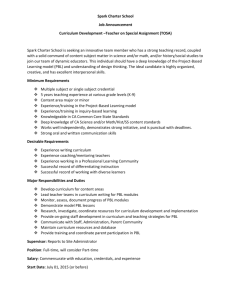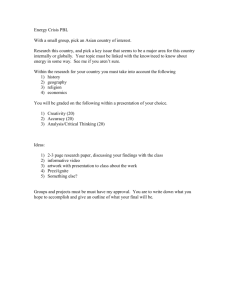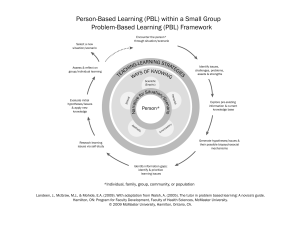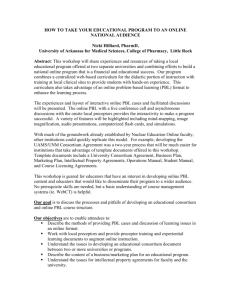PBL Document - Roscoe, Texas ISD
advertisement
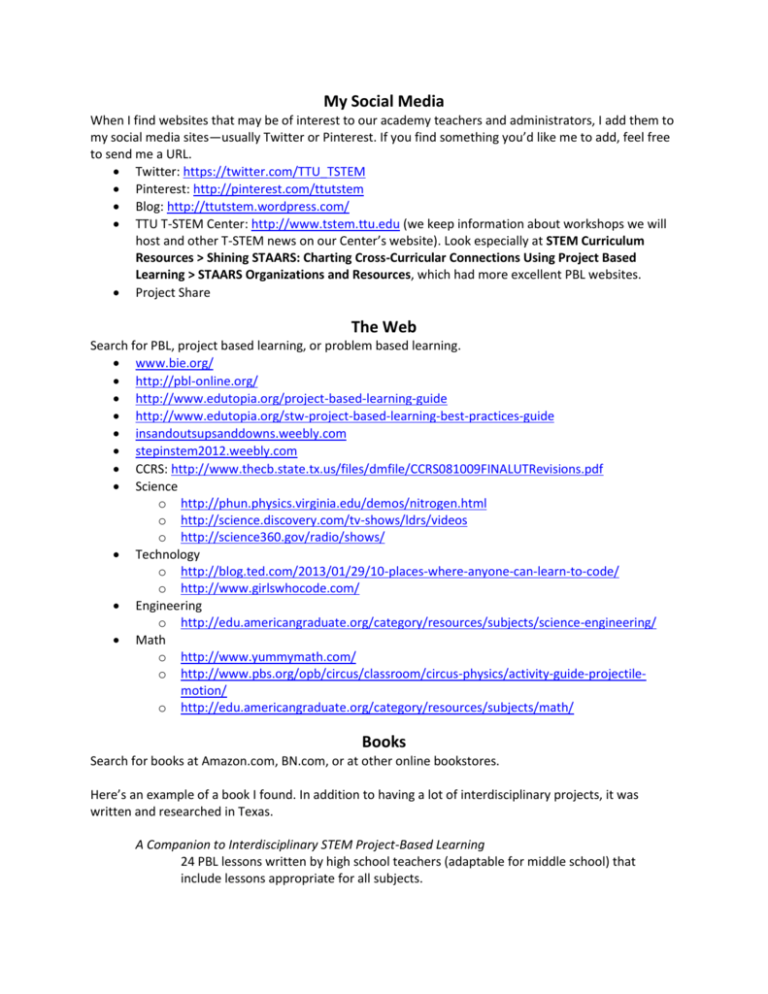
My Social Media When I find websites that may be of interest to our academy teachers and administrators, I add them to my social media sites—usually Twitter or Pinterest. If you find something you’d like me to add, feel free to send me a URL. Twitter: https://twitter.com/TTU_TSTEM Pinterest: http://pinterest.com/ttutstem Blog: http://ttutstem.wordpress.com/ TTU T-STEM Center: http://www.tstem.ttu.edu (we keep information about workshops we will host and other T-STEM news on our Center’s website). Look especially at STEM Curriculum Resources > Shining STAARS: Charting Cross-Curricular Connections Using Project Based Learning > STAARS Organizations and Resources, which had more excellent PBL websites. Project Share The Web Search for PBL, project based learning, or problem based learning. www.bie.org/ http://pbl-online.org/ http://www.edutopia.org/project-based-learning-guide http://www.edutopia.org/stw-project-based-learning-best-practices-guide insandoutsupsanddowns.weebly.com stepinstem2012.weebly.com CCRS: http://www.thecb.state.tx.us/files/dmfile/CCRS081009FINALUTRevisions.pdf Science o http://phun.physics.virginia.edu/demos/nitrogen.html o http://science.discovery.com/tv-shows/ldrs/videos o http://science360.gov/radio/shows/ Technology o http://blog.ted.com/2013/01/29/10-places-where-anyone-can-learn-to-code/ o http://www.girlswhocode.com/ Engineering o http://edu.americangraduate.org/category/resources/subjects/science-engineering/ Math o http://www.yummymath.com/ o http://www.pbs.org/opb/circus/classroom/circus-physics/activity-guide-projectilemotion/ o http://edu.americangraduate.org/category/resources/subjects/math/ Books Search for books at Amazon.com, BN.com, or at other online bookstores. Here’s an example of a book I found. In addition to having a lot of interdisciplinary projects, it was written and researched in Texas. A Companion to Interdisciplinary STEM Project-Based Learning 24 PBL lessons written by high school teachers (adaptable for middle school) that include lessons appropriate for all subjects. from Educate Texas, Foundation of Project Based Learning 2012 Workshop The T-STEM definition of PBL Project-Based Learning is… an inquiry-based instructional approach in a real-world context in which students generate the pathways and products that meet defined, standards-based outcomes. In seeking to create PBLs that meet the rigorous assessment challenges embedded in the T-STEM definition, please keep in mind the 3A’s—Alignment, Authenticity, and Autonomy. Alignment multiple opportunities for feedback data-driven decisions learning objectives aligned to measurable outcomes that are aligned to specifics of standards (nouns, verbs, context, vocabulary) different instruction during duration of project Authenticity Autonomy expert feedback students take initiative assessment practices model assessment cycles used by STEM professionals while generating products students use feedback to make informed choices to improve the quality of their products assesses habit of mind in addition to standards-based content and skills multiple opportunities for feedback students provide feedback to the teacher to improve assessments timely feedback on formative assessments enable students multiple opportunities to improve their knowledge, skills, and products assesses products that require students to apply model to real world problems from Educate Texas www.edtx.org/media-center/blog/back-to-basics-stem-project-based-learning-pbl/ In Texas, the STEM movement has defined T-STEM PBL as an: inquiry-based instructional approach in a real-world context where students generate the pathways and products that meet defined, standards-based outcomes PBL differentiates itself from traditional learning in that it incorporates unique experiences for students that are engaging and relevant. These experiences assist students in mastering content knowledge in different subject areas. In order to engage students, PBL incorporates: Significant content In-depth inquiry Driving Questions Need to know Voice and choice Revision and reflection Public Audience 21st Century Skills (Larmer, 2009) In order to implement PBL into the STEM classroom teachers should approach their lessons by: 1. Identifying the objectives, content and standards for the lesson. These are the non-negotiables; i.e., things that must be taught during the school year, things that are regularly tested for accountability and requirements deemed essential by the district. 2. Establish the goals for the lessons, keeping a realistic issue in mind that will engage students’ interests. An example may be the purchase of a house or the design of a fuel-efficient car. The scenario will explain the problem, the purpose and the intended outcome of the project to be undertaken in a classroom setting. Defining the intended learning outcomes is very important for the student during this step so both teacher and student are in agreement about what is to be completed by the end of the project. STEM-PBL activities are strategically designed and facilitated by the teacher to help students understand why they need to master this content or to be competent in a certain skill set. Five frequently used design processes by teachers and students are engineering, literary research, writing, artistic, and scientific. 3. Evaluate their students’ skills and abilities to complete the project in the timeline given. At the end of a PBL lesson, students are required to exhibit the knowledge learned. This can be completed in or out of the classroom and even through a community exhibition of some sort. In either setting, exhibitions of student work should indicate the dedication to the process of learning and problem solving. The exhibit may take many forms: presentations, theatrical performances, engineering competitions, or even submission of scientific papers to name a few These presentations should not be mistaken as a sole purpose for integrating PBL into the curriculum. While it is essential students develop communication and presentation stills, the purpose of PBL is for students to LEARN and master content. While students are engaged in PBL, teachers might want to: provide reassurance Assist in making those connections with what they are doing and the curriculum being presented Assist students in seeing the big picture and evaluating their options Assist in breaking down the process to manageable tasks Re-direct students to the goal if needed (ODE, 2012) At the end of a PBL lesson, teachers must evaluate not only whether the required goals were met, but they must also evaluate whether or not students actually learned the objective, content or standard that was being presented. In order to do this, teachers should have students reflect on the activity by asking students to respond to questions such as: What have I learned? How can I apply this to other situations? How did I contribute to this process? (ODE, 2012) Citations: Lamar, J., Ross, D., & Mergendoller, J.R. (2009). PBL Starter Kit. Novato, CA: Buck Institute for Education. Ohio Department of Education. (2012, June 1). Using Effective Instructional Strategies: Problem-Based Learning. Retrieved from http://ims.ode.state.oh.us/ode/ims/rrt/research/Content/problem_based_learning_what_this_ means.asp Stotts, J. (2011, August 26). What is STEM PBL? [Web blog] Retrieved from http://www5.esc13.net/thescoop/transformation2013/2011/08/26/what-is-t-stem-pbl/ from Project Based Learning Design and Coaching Guide 10 ways to advance PBL: 1. Teach concepts, not standards. Focus on what PBL does best: teach students to think. 2. Teach critical thinking through contextual challenges. Recent research indicates that critical thinking relies on a blend of attributes, including habits, attitudes, and emotional openness; thinking strategies; background knowledge; conceptual knowledge; and criteria for judgment. All of these can be learned—synergistically—through well-designed projects that challenge students to solve meaningful problems. The lesson for twenty-first century education is that critical thinking cannot be taught as an isolated skill. 3. Start with questions, not curriculum. Questions, whether obviously relevant to students or made relevant through good teaching, engage today’s students. 4. Emphasize innovation. PBL relies on a problem-solving process that requires students to learn and use information to find the solution. In the hands of an advanced practitioner of PBL, a project—from start to finish—is an exercise in critical thinking, collaboration, and demonstration of accomplishments. With this understanding, design projects around the core themes of innovation and creativity. 5. Teach and assess collaboration and communication. Students collaborate as part of their daily life; through projects, they can learn to collaborate purposefully and respectfully. 6. Focus on quality. During a project, provide every student with multiple opportunities to perform deep, quality work. PBL must be designed around a process of excellence, using drafts, prototypes, peer protocols, thinking and brainstorming exercises, and clear performance standards. 7. Teach drive, passion, and purpose. Such intangible assets cannot be taught out of a textbook; they must be activated through experience. 8. Practice planet craft. Designing projects that take students into deep, authentic realms and purposeful learning is a powerful motivator for excellence. 9. Learn from students. PBL allows students and teachers to create fruitful learning partnerships. Students can be trained in project design and help set standards for their own performance. 10. Infuse PBL into technology. 7 design principles: 1. Identify the challenge. Make the challenge both meaningful and doable. 2. Craft the Driving Question. What is the deep understanding that you want your students to have at the end of the project? 3. Start with results. Decide the tasks and outcomes of the project. Content objectives are project specific, but you will also want to include skills mastery and dispositions in your outcomes. 4. Build the assessment. At the end of a project, students produce a result. The result is assessed against specific criteria established at the beginning of the project and defined in an assessment plan. 5. Enroll and engage. Engage students in the project from the beginning. 6. Focus on quality. Quality work results when student teams commit to purposeful collaboration and continuous improvement. Teaching teams to use proven tools and coaching teams to perform better are central to successful projects. 7. End with Mastery. The PBL process is a nonlinear problem-solving process. A good PBL teacher knows how to manage the work flow throughout the project and prepare students to present their best work at the end, including planning powerful exhibitions to public audiences. Most important, at the culmination of well-executed projects, students experience the feeling of mastery. Projects tend to be complex endeavors that yield multiple solutions, rely on nuanced judgment, and require self-regulation on the part of learners. If you want students to be skilled communicators and collaborators, so must you be.

